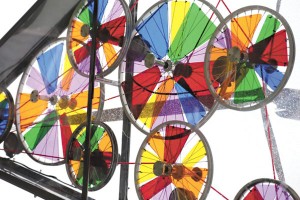by Reconnecting to Our Waterways
Reconnecting to Our Waterways and partner organizations, like the daVinci Pursuit and the Herron School of Art and Design at IUPUI, work together to stimulate neighborhoods through the use of beautiful and very unique outdoor art that not only intrigues the public, but also draws attention to the nearby waterways while creating educational opportunities.
On the near eastside, there are several outdoor art pieces that were created in order to inspire the general public and instill a sense of curiosity. One of them is the Pogue’s Run Rest Stop project: three rest stops — one in the Cottage Home neighborhood, one in Spades Park and one at the Paramount School of Excellence — that are intended to draw attention to the waterways and work in conjunction with the future Pogue’s Run Trail. Three different level of artists built the pieces in an effort to involve a great number of community members: professional artists, student artists from the Herron School of Art and Design at IUPUI, and high school student artists from Arsenal Tech.
One of the professional artists and director of the project, Eric Norduglen, is a Near Eastside resident, ROW Pogue’s Run committee member and a faculty member in the sculpture department at Herron’s. Another professional artist that worked on the pieces is Greg Hull. Hull created three related works, one for each of the Rest Stop locations, called Stone Lanterns. These pieces aim to explore the relationship between visitors and the waterways as a “poetic intersection,” according to Hull, creating a place for contemplation and meditation. While he searched for an active way to bring people closer to the waterway, or bring the waterways closer to the people.
The third expert artist who helped work on these pieces is Emily Stergar. Stergar assisted both Nordgulen and Hull in aiding the students through the development process of the pieces. Stergar worked on the piece entitled Dredge at the Paramount School of Excellence, as well as Reroute at the Cottage Home neighborhood. Dredge is made from dirt that was actually pulled from the White River and cast into blocks that sit at the top of a hill. The blocks cascade down the hill, in an effort to make them look as though they’re making their way back to the creek, according to Stergar. The different pieces have different ratios of dredge to create this feeling of going to the creek. The Reroute piece is similar, except one of the blocks is made from concrete.
Another piece that succeeds in telling a story through art is FLOW, a temporary art piece designed by Wil Marquez located in one of the daVinci ArtPorts on the south side of the Barth Avenue Bridge on South Pleasant Run Parkway. The daVinci ArtPorts are an initiative through the daVinci Pursuit, an organization with a mission to connect art, science and community, according to CEO and founder Mark Kesling. These daVinci ArtPorts create new ways for pop-up art to occur, creating a dynamic, visually appealing landscape for artists. FLOW will move from location to location using the daVinci ArtPorts for the next five years, at which point it will be retired. The pop-up FLOW piece uses musical forms to communicate the surrounding neighborhood’s memories and stories about local waterways. The piece uses three songs or “flows” creatively composed by AJ Vinson, NSB and Phil Nap to inspire the city, promote the environment and showcase a musical experience for everyone. Listen to one of the songs here: https://drive.google.com. Using basic computer programming, FLOW can sense when people pass by, triggering the “flows” to start playing.
Interactive art, like the Ka-bike-O-Scope at Pleasant Run Trail and Barth Avenue and Silver Fall II at Delaware Street and Fall Creek Parkway, helps to directly involve the community with the arts, sciences and the waterways. The Ka-Bike-O-Scope is yet another creative initiative through the daVinci Pursuit in conjunction with ROW. Created by artist Quincy Owens and physicist Luke Crawley, the piece was born from a community-wide design competition with intent to bring science into the neighborhoods. The inspiration for the Ka-Bike-O-Scope was to merge both the artists’ and the neighborhood’s desires together. The neighborhood was looking for something that brought light into the community.
The piece is two-fold, with two large kaleidoscopic kinetic sculptures and two stationary bikes right next to each other. As people pedal the bikes, wheels 18 feet up in the air held in a canopy structure begin to spin, creating a beautiful, colorful pattern from the acrylics inside the wheels. The lights can also be seen at night through LED lighting.
The brand new Silver Fall II is another piece with a purpose: invite its viewers to interact with it. The sculpture is a part of Destination Fall Creek, a neighborhood initiative addressing several improvements, including better access to nature and the Fall Creek waterfront. ROW has helped fund a part of this development.
Silver Fall II was installed in July of this year. The piece is a 1,200-pound sculpture consisted of 10’ tall, curved aluminum panels adorned with falling maple leaves. Artist Scott Westphal created the piece in an effort to make a gateway sculpture celebrating the revitalization of the Mapleton-Fall Creek neighborhood.
Across from Elder W Diggs School 42 on W. 25th St. along the Canal is the Flyer Fish mural. Designed by young local artist Jamahl Crouch, the mural shows a detailed depiction of a fish breaking the barrier of the water and ascending into an endless sky.
The public placements of these wonderfully unique forms of art stir a sense of curiosity within the community and, hopefully, an increased interaction with the waterways. Visit website at www.ourwaterways.org to see new art projects as they develop and more information about Reconnecting to Our Waterways.



